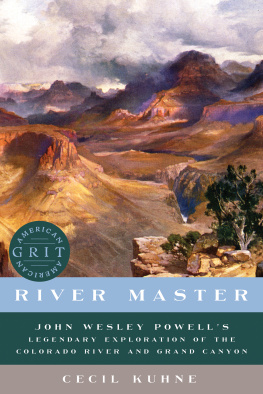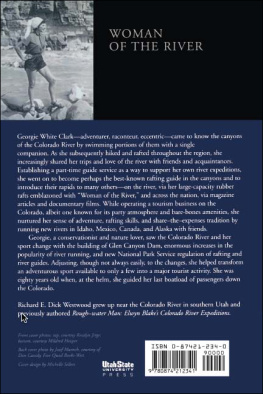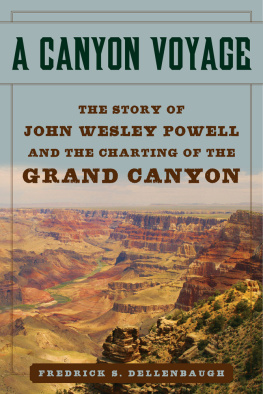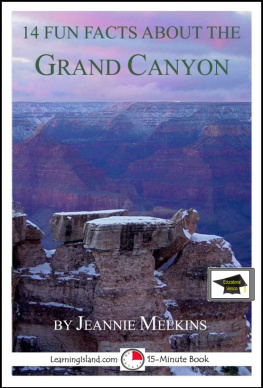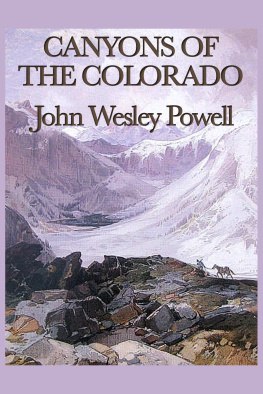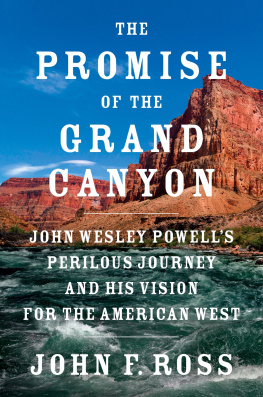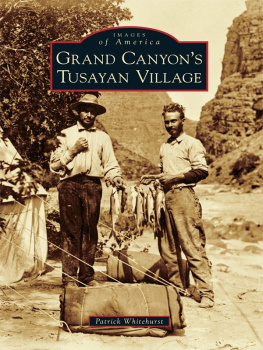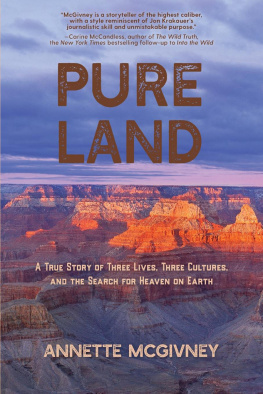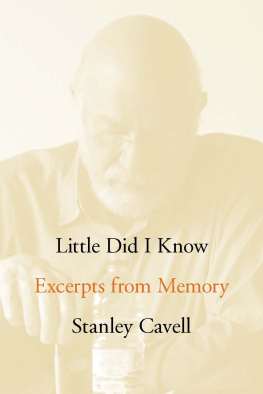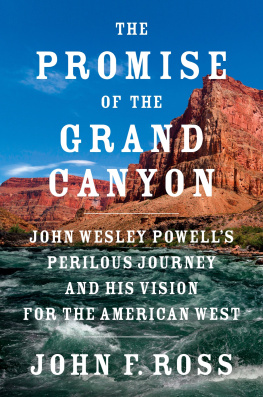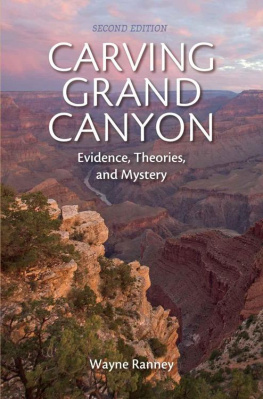

Engraving of Powell Expedition in Grand Canyon by artist R. A. Muller

All photos courtesy of the National Parks Service. Engravings and illustrations originally appeared in The Exploration of the Colorado River and Its Canyons by John Wesley Powell, first published in 1875.
Copyright 2017 by Cecil Kuhne
Map Copyright 2017 by W. W. Norton & Company, Inc.
All rights reserved
For information about permission to reproduce selections from this book, write to Permissions, The Countryman Press, 500 Fifth Avenue,
New York, NY 10110
For information about special discounts for bulk purchases, please contact W. W. Norton Special Sales at specialsales@wwnorton.com or 800-233-4830
Book design by Lovedog Studio
Production manager: Devon Zahn
Jacket art: Grand Canyon of the Colorado , 1908. Painting by Thomas Moran
(1837-1926) /
Photo by Universal History Archive / Getty Images
The Countryman Press
www.countrymanpress.com
A division of W. W. Norton & Company, Inc.
500 Fifth Avenue, New York, NY 10110
www.wwnorton.com
The Library of Congress has cataloged the printed edition as follows:
Names: Kuhne, Cecil C., III, 1952- author.
Title: River master : John Wesley Powells legendary exploration of the Colorado River and Grand Canyon / Cecil Kuhne.
Description: New York, NY : The Countryman Press, 2017. | Includes bibliographical references and index.
Identifiers: LCCN 2017025435 | ISBN 9781682680742 (hardcover)
Subjects: LCSH: Powell, John Wesley, 18341902TravelColorado River (Colo.-Mexico) | Powell, John Wesley, 18341902TravelArizonaGrand Canyon. | Colorado River (Colo.-Mexico)Discovery and exploration. | Grand Canyon (Ariz.)Discovery and exploration | ExplorersColorado River (Colo.-Mexico)Biography. | ExplorersArizonaGrand CanyonBiography.
Classification: LCC F788 .K94 2017 | DDC 910.92 [B] dc23
LC record available at http://lccn.loc.gov/2017025435
ISBN: 978-1-68268-073-5 (e-book)
To Clare
CONTENTS
Time is a sort of river of passing events, and strong is its current; no sooner is a thing brought to sight than it is swe pt by and another takes its place, and this too will be swept away.
Marcus Aurelius

T HE CHALLENGING RAPIDS THAT ROAR NOISILY within its deep, secluded canyons have made the mighty whitewater rivers of the American West justifiably famous among river runners. None of these glistening liquid gems are more renowned than the Green and Colorado Rivers, born among the airy, snow-covered peaks of Wyoming, Utah, and Colorado. The trickling headwaters of these two streams spring forth from the craggy 13,000- and 14,000-foot heights of the Wind River, Uinta, Wasatch, and Rocky Mountain Ranges, and their rivulets wend their way downstream until they finally merge, pulsing through the vast Colorado Plateau and a series of stark and hauntingly beautiful corridors.
The enticing landscape that is found here has been described by historian and noted Colorado River explorer Robert Brewster Stanton as full of strange forms and changing colors which inspire awe, wonder, and amazement, a country in which at every turn one is startled by scenes of grandeur beyond compare, of beauty beyond conception, of coloring so bold, so wild, and yet so delicate and harmonious as to turn an artists brain with despair of being able to catch the mystic, hazy tints of opal, topaz, mauve, pink, and lilac that hang over its deserts, its mountains, and its canyoned gorges. To stand on the shores of wild and majestic natural forces such as these, peer into the closing walls of the lonely and unexplored chasms downstream, and then abruptly shove a boat into the quickening current is clearly not an undertaking for the faint of heart.
An intrepid, but remarkably scruffy, band of ten menknown officially to the world as the Colorado River Exploring Expeditiondid just that as they launched four long, heavily laden wooden rowboats from the dusty banks of the Green River in southern Wyoming. It was the early afternoon of May 24, 1869, and their leader was John Wesley Powell, an ambitiously driven geology professor and former Union major who had lost most of his right arm in the Battle of Shiloh.
With the groups four boatschristened the Emma Dean , the Maid of the Canyon , the Kitty Clydes Sister , and the No Name heavily overloaded with enough food and supplies to last the next ten months, these ten brave individuals (two of whom were added at the last minute) aspired to be the first to probe the unseen depths of the Green and Colorado Rivers as their currents raged southward through the states of Utah, Colorado, Arizona, and Nevada into the Gulf of California. The partys intended destination was a thousand miles of unexplored river downstreama wildly ambitious and undeniably dangerous proposition, to say the least.
Aside from the legendary exploits of Lewis and Clark, the Powell expedition was the most significant and grandiose exploration into the magnificent vistas of the American West. At the time, the Colorado Plateau remained the largest unknown region of a rapidly developing America, and much of this sprawling expanse was truly terra incognita . Biographer William Culp Darrah has described the Powell expedition as the last great exploration into unknown and unmapped country in the United States. Culp also noted that, For sheer bravery, daring, and resourcefulness, the canyon voyage had been inscribed in the annals of American exploration.
Donald Worster, in his book A River Running West , goes even further and boldly asserts, Powells journey down the legendary river of the West was one of the greatest events in the history of American exploration. Only the travels of Meriwether Lewis and William Clark some six decades earlier compare in significance or drama.
In his much-celebrated biography of Powell, Beyond the Hundredth Meridian , historian Wallace Stegner recognized this crowning achievement in the subtitle of his book, which says it all: John Wesley Powell and the Second Opening of the West . Robert Brewster Stanton aptly noted, Whoever may have traversed the great canyons or braved the terrors of the five hundred and more cataracts and rapids of the river, it is but following that little band of 69 who blazed the way.
No one can doubt the profound significance of Powells accomplishment. Yet, in the end, these ten adventurers were poorly prepared for the dangers that they were about to encounter. Without adequate maps, the expedition members had no way of ascertaining exactly where they were. Because they were the first to lay eyes on much of the river, which frequently fell abruptly out of sight, they never knew what foreboding obstacles might lie ahead. The men were no doubt aware they were traveling through a long series of harsh, isolated canyons marked by frequent whitewater rapids. What they could not fathom with their limited knowledge of the terrain ahead was that they were about to encounter the most intimidating rapids in all of North America. One thing was certain: Once the towering canyon walls closed in around them, there would be no easy means of escape.
Serious life-threatening hazards awaited them. Drowning in these swift currents was an obvious danger. But just as likely was the grim possibility of starving to death in the desert. If the group should have the misfortune of losing a boatwhich unfortunately occurred early in the journeythe men would be severely compromised in their efforts to make it out of the canyons alive.
Next page
